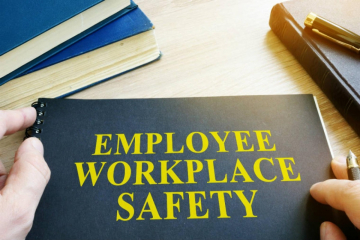After hearing from many of our clients that contractor safety is a recurring pain point, Antea Group held a recent EHSxTech best practices workshop (generously hosted by Autodesk) to dig deeper into this complicated issue. The companies in attendance varied in size and EHS maturity level, but one thing they all had in common was having limited stakeholder buy-in to address contractor safety in their organization.
Low Risk Isn’t No Risk
There was mutual agreement among both larger industry leaders and their smaller counterparts that contractor safety program development, implementation, and maintenance is fraught with obstacles. For younger and/or lower-risk companies, the challenges can be even greater, since these companies tend to outsource higher-risk activities (think construction, HVAC maintenance, landscaping, and cleaning services), increasing program complexity and the chance for a contractor incident. The need for a robust contractor safety program is more important than ever in order to protect your company, employees, and brand.
Multiple business functions need to cooperate to ensure a successful contractor safety program, and often EHS is responsible for leading the way, organizing various stakeholders toward a coherent and consistent contractor safety plan. But this cross-collaboration can be the primary source of anxiety for many organizations—contractor safety can feel like a Pandora’s Box because, once the box is opened, a whole host of risks and contractor management issues (and extra work!) come out, and there’s no putting them back in.
However, there is hope. Below, we’ll walk you through diagnosing your organization’s current situation and help you plan your next steps to move the needle towards a safer, healthier environment for employees and contractors alike.
Know Where You Stand
Maturity models can be useful tools in understanding the status quo at your organization and mapping a gradual path forward. Antea Group’s experts put together the contractor safety maturity model below to serve as a guide.
The lowest maturity stage is characterized by a reactive (rather than proactive) approach, as these organizations have little or no awareness of their risk. At the first level of progression, companies recognize risks exist and put measures in place to limit them via contract language and insurance requirements. Level two organizations begin to operationalize contractor safety risk mitigation, including implementing certain safety requirements for contractors on an informal basis, without a written program. More sophisticated organizations begin to identify high-risk activities or projects and conduct safety assessments before permitting their contractors to commence their work.
By level three, contractor safety emerges as an organizational priority and is addressed with targeted processes, such as evaluating contractor safety performance as part of the procurement process, establishing specific safety expectations in contracts, and sharing written programs and guides with the contractor. In level four, the contractors have become partners, collaborating with the business to embrace contractor safety as a critical requirement of all work. And by the final, most mature stage, the goal has shifted to continuous improvement based on safety metrics tracked to larger organizational goals.
Map the Path Forward
Now that you have a sense of where you are and where you want to go, here is a framework you can use to help get you there.
- Engage with stakeholders: This is no time to be a hero--EHS cannot do this alone. Take the time to map and engage key stakeholders within your company who need to be involved, including Facilities, Real Estate, Project Managers, Legal, Security, Procurement, HR, and more. Besides executive buy-in, you will need on-the-ground champions willing to advocate for resources. This is a good time to explore ways that technology can help streamline your program, including automating tasks or expanding functionality in existing company platforms.
- Determine your triggers: Next, consider your organization’s level of risk tolerance and what corresponding triggers you need to build in to the program. Does it make sense to start with a higher risk tolerance and gradually decrease it over time? Do you want to narrow the scope and tie the process to project cost, vendor type, or facility? Or will it be required for all work across the spectrum? Make sure to true up your expectations against your resources to ensure you aren’t overcommitting.
- Outline your evaluation criteria: The easiest way to maintain a handle on contractor safety is to build it into the procurement or subcontracting process from the beginning. Consider how you might pre-qualify “approved vendors” from an EHS standpoint--what safety performance criteria, documentation or training would you require? Does EHS have the authority to reject or fire a long-term contractor that does not meet the criteria or cannot provide training records? Are criteria the same across the globe, or do they vary by region according to risk? Clearly outline the standards contractors will be expected to meet and how they will be measured against them.
This is also a good time to review your current contracts, and work with Procurement if changes or safety-related additions are needed. Expect any significant changes made to contracts to incur additional costs and time your contract changes to occur at contract renewal time. In cases where contractors have performed work for the company under auto-renew contracts, be sure to plan for regular re-certification or re-qualification of their safety credentials and update their status over time—some companies run into issues with contractors who are grandfathered in and their safety performance is never considered.
- Implement your plan: Once you have your standards in place, you can create your written program and ensure all stakeholders and contractors understand and agree to the organization’s expectations. This will look different for every organization, but possible approaches include requiring vendors to read and sign a contractor safety handbook or sit through a training session before entering the site. Often companies tie badge access or payments to meeting safety standards, providing safety data, or completing training. You could also consider using a third-party service to handle the vetting process, which often includes charging vendors a fee to be pre-qualified to work with you. If you opt for this approach, don’t forget the importance of doing some of your own due diligence to validate the information provided by your vendors.
If you operate in leased space, it’s crucial to understand the terms of your lease and what your landlord is and is not legally responsible for, especially when it comes to hiring and managing subcontractors doing facility maintenance. If these responsibilities don’t align with or aren’t being done according to your safety standards, your cross-functional safety team will need to address this additional layer of complexity.
- Follow up and future-proof: Once you have your program in place, turn your attention to iterating and improving over time. Establish how often your contractors will be required to be re-approved for work with your organization—on every project? Tie this to contract renewals. Determine who will be monitoring contractor status and checking documentation. (This is a great time to empower project or function owners to step up and claim ownership—especially since EHS may not have information on projects coming up or contractors currently at work.)
Define how often your written program will be reviewed and updated, and by which stakeholders. Also, be sure you have set up metrics by which you can measure your program’s impact, and that you have processes in place for data collection and review, and document retention. You should have a remediation plan in place for areas of the business that are out of compliance, and a timeline by which you hope to have everything back in line.
Perfect is the Enemy of Good
By aiming for slow and steady improvement rather than instant perfection, progress is possible even under the tightest resource and budget constraints. Embrace the fact that with contractor management, like health and safety as a whole, it’s always possible to do more, but that doesn’t mean small steps in the right direction don’t make a difference. No matter what, remember that you are not alone, and that organizations of all sizes and in all industries are wrestling with these same issues.
Looking for some extra support with your contractor safety management? Contact us today to talk about your needs.
Want more news and insights like this?
Sign up for our monthly e-newsletter, The New Leaf. Our goal is to keep you updated, educated and even a bit entertained as it relates to all things EHS and sustainability.
Get e-Newsletter
Have any questions?
Contact us to discuss your environment, health, safety and sustainability needs today.





